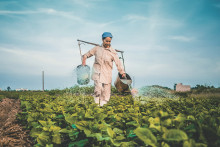Green water is the rainfall that is directly used by vegetation and evaporates back to the atmosphere. Unlike blue water (groundwater and surface water, ed.), which we can clearly see in our lakes, streams and rivers, it is less visible in landscape. Yet, it is the main source of freshwater in the whole world. It is the main source of water to produce food, feed, fibre, timber and bio-energy. And it has its limits – as Schyns and his colleagues clearly show in the recent paper.
‘It is the only source of water to sustain nature’
Joep Schyns (UT Water Management group) explains that, even though green water is vital for our lives, his research represents the first time anybody assessed sustainable limits to its use. ‘Until now, the debate on water scarcity focused on blue water, on the over-exploitation of rivers and groundwater reserves,’ says the postdoctoral researcher. ‘But green water is the only source of water to sustain nature. It is the most important water supply for any biomass production: crops for food, biofuel, or fibres for clothes, animal feed, wood.’
‘We are exceeding the green water limits’
Schyns’ research conclusions are not overly positive for the mankind. ‘In many places we are approaching or even exceeding the green water limits,’ he says. ‘In the paper we show how much green water is used in agriculture and forestry, and how much green water is used in areas where it shouldn’t be. In many places on the planet, including the Netherlands, Germany, Central America and the Middle East, we have used up all the green water flow. It has been applied to human use – agriculture, forestry, urbanization – and there is practically no green water left to use for increased biomass production.’

‘We can’t continue increasing our consumption’
In other words, we have reached the limit. ‘At our consumption level we are at the maximum sustainable level,’ warns Schyns. ‘We can’t continue increasing our consumption without harming nature further – at least not unless we also increase our efficiency. Green water can be used more efficiently by closing yield gaps and by prevention of evaporation from the soil that does not contribute to biomass growth, for example by applying mulches on crop fields.’
‘Yet it is questionable how long efficiency improvements can counteract increasing pressure on green water,’ continues Schyns. ‘Population growth and shifts towards more consumption of animal products and energy from biomass per capita contribute to a growing green water footprint, while green water availability remains limited. There are global limits to water for our food and we all contribute to reaching those limits through our consumption. We should especially think of our consumption of animal products which have a large green water footprint compared to plant-based products.’
This research shows that green water is a critical and limited resource and should therefore be included in all assessments of water, food and energy security, points out the scientist. ‘That is the only way we can have the full picture of how humanity uses available freshwater resources.’







